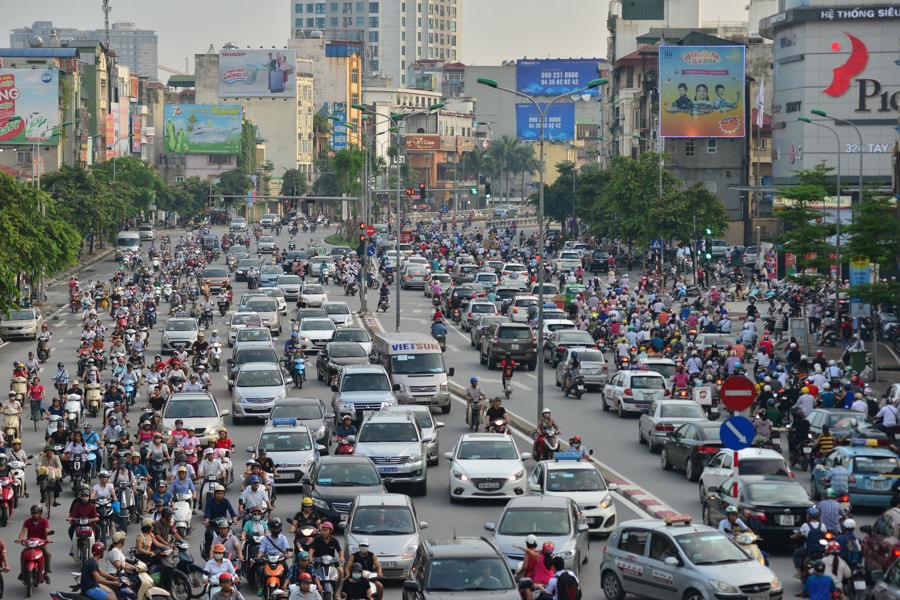
Hanoi will take action to achieve at least 75-80% of the days in the year with a good and moderate air quality index by 2030, focusing on reducing PM2.5 emissions from major sources by about 20% compared to 2019, which is equivalent to approximately 6,200 tons of PM2.5.
This is a key content under the Hanoi People's Committee's plan for managing air quality in the city until 2030, with a vision toward 2050 in response to the growing air pollution concerns.
| Transportation remains a major source of air pollution in Hanoi. Photo: Cong Hung/The Hanoi Times |
Numerous experts have voiced their approval for such an initiative, emphasizing the urgent need for the city to prioritize addressing emissions from air pollution sources, particularly those stemming from transportation, to achieve this target.
Air pollution has had an incalculable impact on public health and the economy, with cases of cardiovascular and respiratory illnesses increasing every year.
Expert Kim Van Chinh from the Environmental Monitoring and Modeling Research Center stated that with rising PM2.5 concentrations, Hanoi is estimated to experience 1,062 additional hospitalizations due to cardiovascular diseases and 2,969 inpatient admissions due to respiratory diseases each year. The estimated cost of air pollution in Hanoi is around VND2 trillion ($78.7 million) per year in 2011-2015.
A report from the Hanoi Department of Natural Resources and Environment revealed that air pollution in the city is a pressing issue. On more than 30% of the days monitored throughout the year, the air quality index (AQI) levels were rated as poor or very poor.
The average annual PM2.5 concentration in Hanoi is almost twice the national technical standards. Between 2017 and 2020, the city's annual average PM2.5 consistently exceeded national standards and was more than eight times higher than the WHO's recommendations. Studies show that transport is the largest source of PM2.5 emissions, accounting for between 58% and 74%.
The second largest source is industrial production, contributing between 14% and 23% of emissions. Other sources include agriculture at 3.4% to 18.9%, domestic activities at 6.2%, and waste burning at 2.2%. Daily, Hanoi consumes around 80 million kW of electricity and millions of liters of gasoline and oil, in addition to frequent burning of agricultural byproducts and spontaneous waste burning. These are the sources of greenhouse gas emissions causing environmental pollution, especially air pollution.
Substantial measures required
Do Van Nguyet, Director of the organization Live & Learn, believes that identifying the main sources of air pollution in Hanoi, particularly from traffic, is crucial to implementing effective measures to protect air quality.
However, she also emphasizes that air pollution is a "disease" caused by multiple "sources of illness," not just emissions from transport. Therefore, treating the "disease" requires a comprehensive and synchronized approach. She stated that a disease caused by multiple sources is harder to treat, and Hanoi's air pollution is a complex issue.
According to her, Hanoi faces both opportunities and challenges in tackling air pollution. The opportunities include successful environmental protection models currently being implemented.
Nguyet also praised Hanoi's effective communication efforts, which have spread environmental protection messages that resonate with the public, especially the younger generation. This foundation is critical to achieving environmental goals in Hanoi and throughout Vietnam.
She spoke of surveying in a central province far from Hanoi, where air pollution is not as severe. “Surprisingly, the young participants showed great interest in Hanoi's air pollution issues, which they learned about through various media channels,” she noted.
This demonstrates the effectiveness of environmental communication efforts, while the younger generation's interest in environmental issues is promising. However, Hanoi faces challenges, such as rapid urbanization and its impact on environmental protection, particularly air quality.
Addressing policy bottlenecks
Nguyet highlighted another challenge Hanoi must overcome to meet its air quality goals: policy bottlenecks, particularly in controlling motorcycle emissions. Since motorcycles are a primary means of livelihood for many, there is resistance to emission controls.
Addressing this challenge requires public awareness and a change in perception of motorcycle emission control.
Dr. Nguyen Huong Hue, from the Sustainable Transport Unit of the French Development Agency (AFD), also discussed the need to reduce emissions from transport, emphasizing the importance of developing public transport.
According to Hue, public transportation transport in Hanoi currently meets only 10-15% of demand, which is a modest figure. Worldwide, one person dies every 13 minutes from air pollution.
Hue pointed out that air pollution is a global issue, not just one for Vietnam or Hanoi, expecting greater attention should be paid to protecting air quality, especially by developing public transport in Hanoi. "Why do we refuse to drink dirty water but accept to breathe dirty air?" Hue said.



